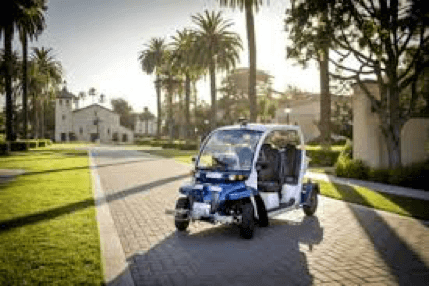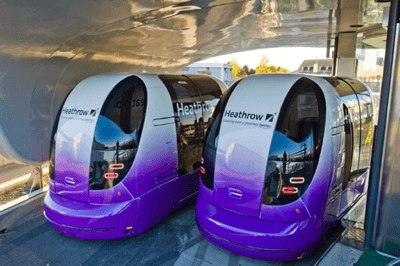
While original equipment manufacturers (OEMs) like Ford, Tesla, Honda, GM and tech giants like Google are making headlines for their accomplishments in the autonomous vehicle (AV) industry, there are numerous smaller companies that have been making huge strides in the industry while flying under the radar.
Most, if not all, media covered AV production and testing revolves around mainstream, highway-safe, multi-passenger automobiles. However, there are many companies in the AV industry that are focusing on a multitude of areas – other than mainstream highway travel.
Some of these companies include Auro Robotics, Wepods, Ultrapods, Dru, Autonomous Racing Vehicles, and many more.
While the implications of roadway, long-distance travel may, on the surface, seem to be the only discovery to be news-worthy – a closer look at these lesser-known companies will reveal a focus and drive that are seldom seen even among the tech giants of the world.
Auro Robotics
 Auro Robotics a Silicon Valley startup has a clear and well-defined focus in the autonomous vehicle industry.
Auro Robotics a Silicon Valley startup has a clear and well-defined focus in the autonomous vehicle industry.
Their niche?
Autonomous transportation across the grounds of private businesses, establishments, and organizations – be it learning institutions, theme parks, retirement communities, or luxury resort destinations.
The applications are vast under these circumstances; the transportation of the elderly, injured students, top-tier guests, and theme park visitors.
What’s the cost benefit?
Autonomous vehicles in these areas particularly can provide a fantastic cost to benefit ratio. The reasoning behind the cost advantage of driverless transportation units is just that – they are driverless. According to Auro Robotics, this could mean operating cost savings of up to 40-60%.
Having received over $2 million in seed funding, Auro Robotics has a clear-cut, defined path for success.
WEpods
 WEpods are autonomous shuttles, carrying up to six passengers at a time from the towns of Wageningen and Ede in the province of Gelderland, in the Netherlands.
WEpods are autonomous shuttles, carrying up to six passengers at a time from the towns of Wageningen and Ede in the province of Gelderland, in the Netherlands.
While this may seem like a small feat in comparison to the strides some of the giants in technology and the automotive industry are making when it comes to AVs, but it is a far cry from small potatoes.
How do they work?
They take the greatest components from some of the biggest leaps in technology; GPS, 3D mapping, laser scanners, full 360o cameras, radar – the works. However, it is applied more efficiently and more focused on an urban commute.But that’s not the best part: you can schedule a pickup via the WEpod app.
Testing
In January of 2016, WEpod took to the streets in an unprecedented testing phase; the first of its kind. It successfully transported 6 people down a stretch of road 200m long.Its testing phase conditions stipulate that it shall not operate during rush hour traffic, inclement weather, or at night – but its success is looking more promising than most automobile giants in the industry.
Ultrapods
 Ultra-Pods from Ultra Global, are one of the most sophisticated and successful autonomous transport vehicles in existence. They are active, and have been for some time now. Primarily used at Heathrow Airport, they are being conditioned and proposed for urban transportation, as well as for commercial and privatized use in colleges, resorts, private residential establishments, and more.
Ultra-Pods from Ultra Global, are one of the most sophisticated and successful autonomous transport vehicles in existence. They are active, and have been for some time now. Primarily used at Heathrow Airport, they are being conditioned and proposed for urban transportation, as well as for commercial and privatized use in colleges, resorts, private residential establishments, and more.
How many passengers?
In May of 2013, it celebrated its 1 millionth mile driven autonomously. The Ultra Pod system has accommodated over 700,000 passengers at Heathrow, with its 21 car system.
Where else are they used?
Heathrow is not the only place Ultra Pods are used; Amritsar North India is also home to the passenger rapid transport system (PRT). As the first urban application in use in Amritsar, it has the ability to transport over 100,000 passengers every day with well over 200 active pods.
With a flawless history and nearly endless applications, Ultra Pods has as bright a future as its past.
EasyMile
A fully autonomous bus developed by the French firm EasyMile has been deployed at business parks and other smaller venues in Finland, France, Italy, Spain, and Switzerland. The electric EZ10 can accommodate up to 12 passengers. Its lithium-ion battery can be fully charged in eight hours, giving the EZ10 up to 12 hours of operation and a range of up to 50 miles. It has an average cruising speed of up to 12 miles per hour and a top speed of 25 miles per hour.
What problem does it solve?
 The EZ10 is designed for last-mile travel, such as between travel hubs and final destinations, or for looped routes within confined areas, like airports, city centers, and business parks. Unlike a tram or train, it does not require special infrastructure to travel on. Instead, a route or “virtual line” is created for the vehicle to follow, which can then repeat continually. A mix of localization navigation and obstacle detection/avoidance technologies are used to ensure the vehicle stays on course and negotiates hazards.
The EZ10 is designed for last-mile travel, such as between travel hubs and final destinations, or for looped routes within confined areas, like airports, city centers, and business parks. Unlike a tram or train, it does not require special infrastructure to travel on. Instead, a route or “virtual line” is created for the vehicle to follow, which can then repeat continually. A mix of localization navigation and obstacle detection/avoidance technologies are used to ensure the vehicle stays on course and negotiates hazards.
The EZ10 recently conducted a two-week trial at the Gardens by the Bay park in Singapore, and a full-scale rollout is expected in mid-2016. Another trial is slated to begin in mid-2016 at the Bishop Ranch business park in San Ramon, California.
DRU
 Dominos Pizza recently unveiled plans for the first driverless delivery vehicle. Dubbed DRU, for Domino’s Robotic Unit, the four-wheeled vehicle with pizza box-sized compartments has been designed for the pizza giant with help from Australian startup Marathon Robotics.
Dominos Pizza recently unveiled plans for the first driverless delivery vehicle. Dubbed DRU, for Domino’s Robotic Unit, the four-wheeled vehicle with pizza box-sized compartments has been designed for the pizza giant with help from Australian startup Marathon Robotics.
“This highlights what can happen when disruptive thinking is fostered — It turns into a commercially viable and revolutionary product,” said Dominos Group CEO Donald Jeffrey Mei. “It allows Domino’s to explore new concepts and push the boundaries of what is possible for our customers.”
Autonomous Racing Vehicles
 In the world of competition sports entertainment comes autonomous racing vehicles. Entries such as Roborace, debuting in late 2016, early 2017, will feature fully autonomous, high-octane racing vehicles.
In the world of competition sports entertainment comes autonomous racing vehicles. Entries such as Roborace, debuting in late 2016, early 2017, will feature fully autonomous, high-octane racing vehicles.
Behind the design
The vehicles is designed by Tron: Legacy light-cycle designer, Daniel Simon.
What makes them go?
It has just recently been confirmed that the brains behind these “smart cars” will be none other than the Nividia Drive PX2 supercomputer.
At 24 trillion (yes, trillion) operations per second (yes, per second), the PX2 utilizes 12 CPU cores, producing 8 teraflops of raw computing power. That should be enough to make these AVs of sports world absolute autonomous monsters.
While each of these companies have demonstrated that they are true pioneers in their niche, they are not alone. As AVs continue to develop in the coming years and there are yet many hurdles to pass, one thing is for sure, its going to have a significant impact on our lives. And in time the technology will prove itself in terms of safety, reliability, savings and convenience. Exciting times ahead!
By: Deepti Tiku, Director of Marketing, Ridecell


